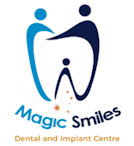
Tooth replacement is a reality for many seniors. One of the most common types of tooth replacements is dental implants. Many may ask whether they are too old for dental implant surgery. The short answer to that question is no.
Dr. Arpit Pathak at Magic Smiles Dental and Implant Centre can help you determine dental implant surgery is right for you.
What are dental implants?
Dental implants are artificial tooth roots that resemble screws. The implants are inserted into a patient’s mouth and they bond with natural bone. An abutment, or connector, is then placed on top of the implant. This abutment acts as the base for the replacement tooth or “crown” to be placed on top.
Dental implants have become among the strongest, safest, and most successful dentistry procedures around. Their success rate is near 98%.
What are the steps to getting a dental implant?
The process of getting a dental implant occurs in several steps:
- Consultation. Your dental professional will examine the implant site, using X-rays or 3D scans, and explain implant options for you.
- Implant installation. At the next appointment, your dentist will insert the implant in your jaw at the site of the missing tooth. Keeping in mind that everyone’s experience differs, most patients say they’ve experienced less pain and discomfort than they expected. Many patients report returning to work the next day. The discomfort experienced post-surgery is like that experienced after other dental surgeries. Swelling, some pain, and minor bleeding are to be expected. Most patients successfully manage the symptoms with over-the-counter medications. The dental surgeon will usually use stitches that self-dissolve. If the dentist uses stitches that do not dissolve on their own, he will remove them for you in a follow-up visit.
- Osseointegration. The process by which the jawbone begins to bond with the implant is known as osseointegration. Your dentist may recommend eating only soft foods for several weeks to ensure the success of this phase. Within weeks, most patients can resume their normal eating habits.
- Placement of abutments. After the bone and implant have successfully bonded, your dentist will place the abutment on top of the dental implant. The abutment is the connector on top of which the replacement tooth, or crown, will be placed.
- New teeth. Once gums are fully healed from the initial surgery, your dentist will custom make your new teeth by taking molds, or impressions, of your mouth. Upon completion, the new restorations are inserted on top of the abutments.
Is implant failure possible?
Most dental implant procedures for seniors are successful. There are cases, however, where osseointegration, or the fusion of the bone with the implant, does not take place. In cases like this, the implant is removed and the procedure can be retried in about three months. Patients may also opt for a dental bridge or denture.
How do I care for my new implants?
To get the most out of your new implants and help ensure they last a long time the patient can take care of them by:
- Brushing and flossing regularly, as you would for natural teeth
- Getting regular checkups at your dental office, as well as regular cleanings
- Avoiding harmful habits like chewing very hard foods like ice or hard candy
Dental Implants in Coffs Harbour
Dr. Pathak and his team are ready to answer any and all questions you may have about dental implants. Call any of our three convenient locations (Coffs Harbour – (02) 6652-3242 or Woolgoolga – (02) 6654-0650) or schedule a free consultation online today.






Recent Comments